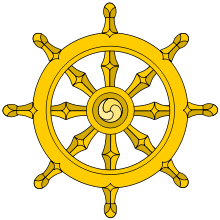
The four key words in the “Buddhist Terms” category are dharma, kalpas, path, and sangha. This category is self-explanatory in that all these words are Buddhist terms or refer to Buddhist terms.
Dharma, as we discussed in the teaching category, refers to the teachings of Buddha, which is, of course, a very important part of the religion.
Kalpas is a Buddhist term for an aeon, or a period of time that measures the length of existence or eternity. It is said that the worlds follow a cycle of kalpas, measuring around 4 billion each. The repeated phrase in this Lotus Sutra chapter is that one of the buddhas, Candrasuryapradipa, is claimed to have “remained sitting for sixty intermediate kalpas.” In this instance, this is considered a hyperbole because it is impossible for someone to sit for his or her entire lifetime, let alone for an eternity. The repetition of this phrase (eight times in this chapter), perhaps, drives in the greatness of this buddha, who was able to sit for such a long time. Because this image is emphasized so much, then, perhaps people will consider it, not just as a hyperbole, but as a religious point that is trying to be made.
Phrases referring to the “buddha path,” also referred to as the “supreme” or “highest” path, allude to the way in which it is important to follow the path that buddhas take in order to reach a certain level of spirituality. The fact that it is repeated (seven times in this chapter) shows the importance of following the buddha path. The authors of the Lotus Sutra changed “buddha path” to “supreme path” and “highest path” then to establish that the buddha path is the path of highest spirituality, and it should be followed.
Sangha refers to the Buddhist community, perhaps including monks and nuns. The inclusion of the sangha in the phrase “Buddha and the sangha” may bring authority into the piece. It shows that people accompanied the Buddha, implying that there was something important or special about him and his teachings that compelled members of the sangha to follow him.